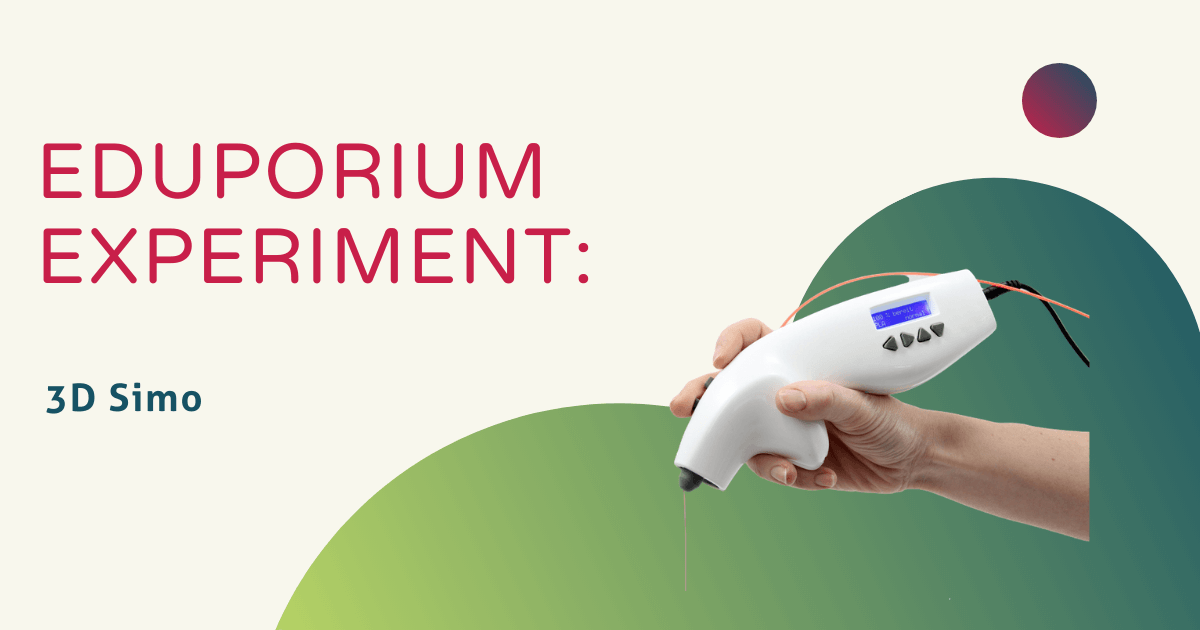Searching for a 3D printing pen that can do it all? The 3D Simo Mini has four functionalities, including 3D printing, soldering, burning, and foam-cutting, making it an ideal STEM tools for starting a makerspace! Just change the tip and you have a whole new tool. It can connect via Bluetooth to a device outfitted with the 3D Simo app, where students can create material profiles, watch instructional videos, and find templates. The app is available for iOS, Android, and Windows devices, however, it’s not required for use because basic material profiles are displayed on the side of the pen. There is also a mini manual and a few filaments included in the box with the pen, tips, and charging cable!
There is so much students can do with the 3D Simo pen. Not only can they power it with a simple USB connection, but a magnetic power pack is also available (separately) for cable-less working. The four different tips easily snap on to the pen as well. With the 3D drawing tip, kids can print endless 3D models or repair items they’ve created in the past.
The temperature and speed are each adjustable and use various filaments, such as PLA, ABS, Hips, Wood, Flex, Metal, and more. With the burning tip, kids can get creative and redesign wood and leather items as well as smooth out 3D printed models. The soldering tip allows them to repair cables and create their own appliances as it fully heats up in just 10 seconds. Lastly, with the foam cutting tip, students of any skill level can cut and model various materials to create unique models!
For this experiment, I chose to try out the 3D printing tip. I plugged it in via the USB slot, inserted some PLA filament, selected PLA, and let the pen heat up. I knew it was done heating when the LED message on the side of the pen changed from “PLA heating” to “ready.” It took less than three minutes to heat up! To print, all you have to do is hold down the front button. I created a cube and few triangle models with gold PLA filament. The plastic came out easily and dried insanely fast, which very much impressed me. The printed material wasn’t hot to the touch, but the very tip of the pen definitely reaches a high temperature, and rightfully comes with a burn warning on the box.
One cool feature of the 3D pen is the ability to press both front buttons for 2 seconds to activate continuous extrusion that can be easily deactivated by pressing either button again. This allows users to relax their hands a bit when creating larger models. At one point, the nozzle became dirty with extra filament drying on it. In the manual, they recommend using a paper towel to wipe it clean, but to be careful because the tip is very hot. I folded the paper towel a few times to clean it and it worked very well. When I was done printing, I held the second front button to remove the filament as instructed. It took longer than expected, but, ultimately, it all came out.
In the end, I found the 3D Simo to be a sleek tool that is easy to use. The 3D printing function worked well, and I’m excited to try out the other tips next time! It is remarkable how so many functions are packed into one pen. If a 3D printer doesn’t fit your budget or you don’t have the space for one, this is the next best thing! It is truly a STEAM tool, and its versatility is hard to beat.
Its simplistic design and innovative capabilities have the potential to inspire kids to use technology to build design, creative, and engineering skills. To purchase one for your classroom (or yourself), visit the Eduporium store! And, look out next Wednesday for the next edition of the Eduporium Experiment featuring Puzzlets! In the meantime, don't forget to follow us on Twitter and Instagram, for more and you might as well like us on Facebook, too!



